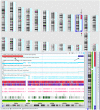Molecular cytogenetic analysis of partial monosomy 10p and trisomy 10q resulting from familial pericentric inversion (10): a first case report in Chinese population
- PMID: 35672790
- PMCID: PMC9175330
- DOI: 10.1186/s13039-022-00599-w
Molecular cytogenetic analysis of partial monosomy 10p and trisomy 10q resulting from familial pericentric inversion (10): a first case report in Chinese population
Abstract
Background: Chromosome aberrations of 10p monosomy and 10q trisomy resulting from parental pericentric inversion 10 are extremely rare, and to date, very few reports have been published on the matter.
Case presentation: A 30-year-old pregnant woman with recurrent pregnancy loss is enrolled in this research. In this pregnancy, spontaneous abortion occurred in the first trimester of her pregnancy. Chromosomal microarray analysis of the abortion tissue showed a partial 10p monosomy (arr[GRCh37] 10p15.3p11.21(100,047_34,848,853) × 1) and a duplication of 10q (arr[GRCh37] 10q26.13q26.3(126,093,990_135,426,386) × 3). Further parental karyotype analysis indicated that the chromosomal abnormalities in the fetus was resulted from paternal pericenric inversion inv(10)(p11.21q26.13). This study presents the first case of a large deletion of 10p combined with 10q trisomy, resulting in pregnancy loss. Of these two manifestations, the large deletion of chromosome 10p may be the primary reason for spontaneous abortion in this subject.
Conclusions: This study presents the first case of partial 10p monosomy associated with 10q trisomy in Chinese population. It provides more information on the chromosome aberration of 10p monosomy and 10q trisomy and further strengthens the application value of microarray in the molecular etiological diagnosis of recurrent spontaneous abortion.
Keywords: Molecular cytogenetics; Monosomy 10p; Pericentric inversion; Recurrent spontaneous abortion; Trisomy 10q.
© 2022. The Author(s).
Conflict of interest statement
The authors declare that they have no conflicts of interest.
Figures


Similar articles
-
Prenatal diagnosis and molecular cytogenetic characterization of rec(10)dup(10p)inv(10)(p11.2q26.3) in a fetus associated with paternal pericentric inversion.Taiwan J Obstet Gynecol. 2016 Oct;55(5):733-737. doi: 10.1016/j.tjog.2016.07.007. Taiwan J Obstet Gynecol. 2016. PMID: 27751426
-
Prenatal diagnosis and molecular cytogenetic analysis of partial monosomy 10q (10q25.3-->qter) and partial trisomy 18q (18q23-->qter) in a fetus associated with cystic hygroma and ambiguous genitalia.Prenat Diagn. 2005 Jun;25(6):492-6. doi: 10.1002/pd.1179. Prenat Diagn. 2005. PMID: 15966044
-
Prenatal diagnosis of partial monosomy 2q (2q37.3→qter) and partial trisomy 10q (10q24.31→qter) of paternal origin associated with increased nuchal translucency and abnormal maternal serum screening results.Taiwan J Obstet Gynecol. 2020 Sep;59(5):758-762. doi: 10.1016/j.tjog.2020.07.024. Taiwan J Obstet Gynecol. 2020. PMID: 32917332
-
Familial 10p trisomy resulting from a maternal pericentric inversion.Am J Med Genet. 1994 Feb 1;49(3):281-7. doi: 10.1002/ajmg.1320490308. Am J Med Genet. 1994. PMID: 8209887 Review.
-
Trisomy 10p syndrome owing to maternal pericentric inversion.J Med Genet. 1990 Apr;27(4):264-6. doi: 10.1136/jmg.27.4.264. J Med Genet. 1990. PMID: 2182876 Free PMC article. Review.
Cited by
-
Etiological diagnosis of miscarriage by combining use of chromosomal microarray analysis and whole-exome sequencing.Eur J Med Res. 2025 Jul 1;30(1):528. doi: 10.1186/s40001-025-02709-x. Eur J Med Res. 2025. PMID: 40598400 Free PMC article.
References
-
- Dhillon RK, Hillman SC, Morris RK, McMullan D, Williams D, Coomarasamy A, et al. Additional information from chromosomal microarray analysis (CMA) over conventional karyotyping when diagnosing chromosomal abnormalities in miscarriage: a systematic review and meta-analysis. BJOG. 2014;121(1):11–21. doi: 10.1111/1471-0528.12382. - DOI - PubMed
-
- Ciuladaite Z, Preiksaitiene E, Utkus A, Kučinskas V. Relatives with opposite chromosome constitutions, rec(10)dup(10p)inv(10)(p15 1q26 12) and rec(10)dup(10q)inv(10)(p15 1q26 12), due to a familial pericentric inversion. Cytogenet Genome Res. 2014;144(2):109–113. doi: 10.1159/000368863. - DOI - PubMed
Grants and funding
LinkOut - more resources
Full Text Sources

